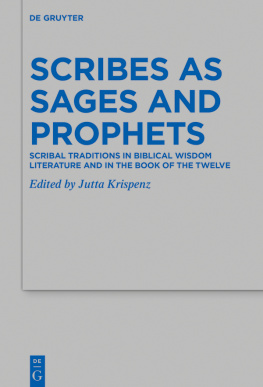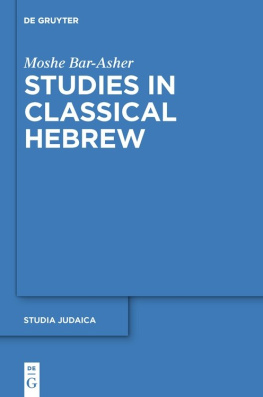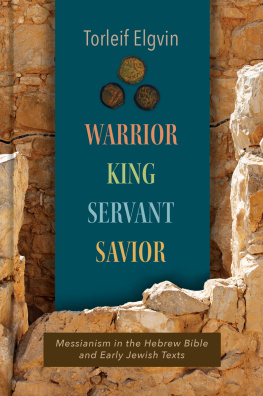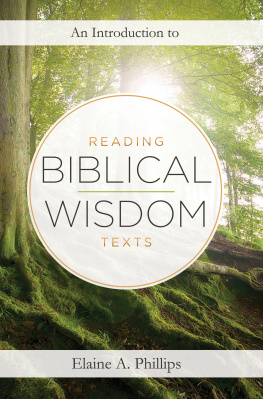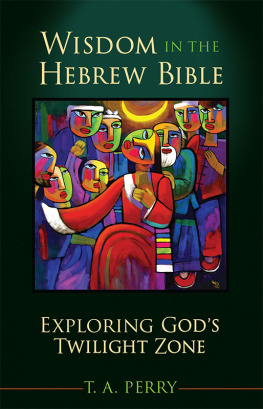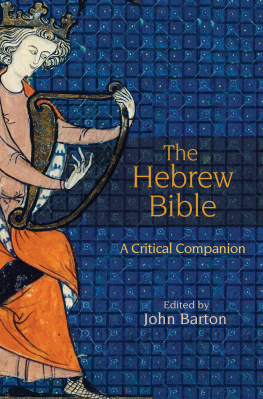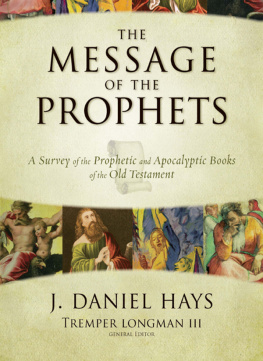Content
Guide

Scribes as Sages and Prophets
Beihefte zur Zeitschrift fr die alttestamentliche Wissenschaft

Edited by
John Barton, Reinhard G. Kratz, Nathan MacDonald, Sara Milstein, Carol A. Newsom and Markus Witte
Volume 496

ISBN 978-3-11-047727-6
e-ISBN (PDF) 978-3-11-048360-4
e-ISBN (EPUB) 978-3-11-048243-0
ISSN 0934-2575
Library of Congress Control Number: 2020938352
Bibliographic information published by the Deutsche Nationalbibliothek
The Deutsche Nationalbibliothek lists this publication in the Deutsche Nationalbibliografie; detailed bibliographic data are available on the Internet at http://dnb.dnb.de.
2021 Walter de Gruyter GmbH, Berlin/Boston
www.degruyter.com
Acknowledgments
First of all, I would like to thank the authors of the articles in the present volume for their willingness to contribute to this collection. Without their work this book would simply not exist.
Moreover, I would like to thank Prof. Dr. Markus Witte and Prof. Dr. Reinhard G. Kratz for accepting this collection of essays for publication in the BZAW series and for their helpful comments and suggestions.
Josephine Haas (Marburg) took the trouble of proofreading a portion of the articles; I am very grateful for her work.
Dr. Sophie Wagenhofer and Dr. Eva Frantz at De Gruyter guided me through the process of editing with expertise and unwavering friendliness. It has been a pleasure to work with them.
Jutta Krispenz
Introduction
The articles collected in this volume discuss the intertextual relationship between the prophetic writings in the Book of the Twelve Prophets and the wisdom literature of Israel. A discussion on this topic has been going on for many years under the heading wisdom influence on prophetical texts, while the complementary question of prophetic influence upon wisdom texts has hardly been a matter of dispute at all. In this volume both perspectives shall be taken into consideration; the contributions will clarify why attempting a fresh look at both prophetic and wisdom texts and the possible intertextual links between them is worthwhile. The chapters, summarized in the fourth and last paragraph of this introduction, are related to a new approach to the formation of the Hebrew Bible which has emerged from a lengthy debate over the history of the biblical texts and their relation to the history of Israel in its Ancient Near Eastern context.
In the opening paragraphs below, I will present this approach in three steps, starting with a look at wisdom and the school context in ancient Israel and how the traditional view of both has become problematic within scholarship of the Hebrew Bible. The second step will consist in summarizing how our conception of prophecy and the role of the prophet has changed in recent years. The third paragraph will discuss the social and intellectual framework of the literature of ancient Israel, a discussion which has culminated in the studies of David Carr and Karel van der Toorn. These two studies changed and reorganized our imagination of the processes which generated the Hebrew Bible. They have provided a new scholarly baseline for reconstructing not only the history of biblical texts but also the history of ideas in biblical times. This introduction concludes with a fourth section which briefly summarizes the books individual essays.
1.Wisdom and School
Since the time of Fichtners work Jesaja unter den Weisen Wisdom has appeared to become a label which can be fixed to any given text. And the statement that a text has didactic qualities and thus should be seen as a school-text has turned out to be quite vague, since any sort of text which conveys a content that might be new for the addressee could fall into the category of didactic.
Moreover, the picture of the school in ancient Israel had until recently been standing on weak foundations. The Hebrew Bible itself does not give us too much information about the school in ancient Israel. The older standard studies by Klostermann and Drr rely mainly on the sparse information contained in the biblical texts, reading these as conveying historical information and completing the picture by reference either to the institutions of their own time or by congenially inventing the missing parts e.g., the curriculum, etc. Nonetheless his procedure still relied heavily on biblical texts as historical sources. The educated segments of society in ancient Israel had in all these presentations not very much to do with other groups in the same society. Generally speaking, there used to be an inclination towards reconstructing ancient Israelite society as a segregated society with very little communication between the different social strata.
Discussion on the topic has changed at this point: for a reconstruction of the possible form of schools in preexilic Israel, scholars have now included consideration of the educational settings in neighboring cultures, especially Mesopotamia and Egypt, which are much better known to us by now. And in recent years discussion has also approached the question of whether the texts of the Hebrew Bible were transmitted orally or in written form.
But even if we now have a better and possibly more correct image of the school in ancient Israel, we must ask what that knowledge implies for our understanding of the texts. Categorizing biblical texts as school texts remains questionable: The material from Mesopotamia, which mainly consists of tablets containing writing exercises, differs from what we find in the Bible. It looks as though pupils in a Mesopotamian school started with copying words, often Sumerian words, only later moving on to copying actual texts. All the copied texts including the Sumerian word-lists were already part of the cultural heritage. A schoolbook, as an ensemble of texts written and combined for use in schools, obviously did not exist in the Mesopotamian cultures.
Things were different in Egypt: the existence of the book Kemit had been known to Egyptologists for a long time, But the Kemit does not resemble very closely the wisdom texts of the Hebrew Bible either: it consists of formulas for letters to persons of different social standing, a little narrative, and a section with sayings. And even regarding this text, which beyond all doubt is a school text, we must say that its content does not become more comprehensible for us through its connection with the school. This is as true for the Ancient Near East as it is for our time: almost every text could be used as a school-text. School-text is not a genre.
Doubt about the school as the natural and only setting, the Sitz im Leben , of wisdom texts is connected with doubt over the existence of specific wisdom-genres. The genres we find in wisdom texts are documented in non-wisdom-texts as well. Does this betray intertextual links? Or does it show that literary forms and genres we see in both areas are not specifically wisdom forms or genres?
The same ambivalence applies to vocabulary. There are words which are mainly used in wisdom texts, tion of the distribution of a group of words indicating the common ideological background of certain texts rather than one of specific singular words marking a text as a wisdom-text.

